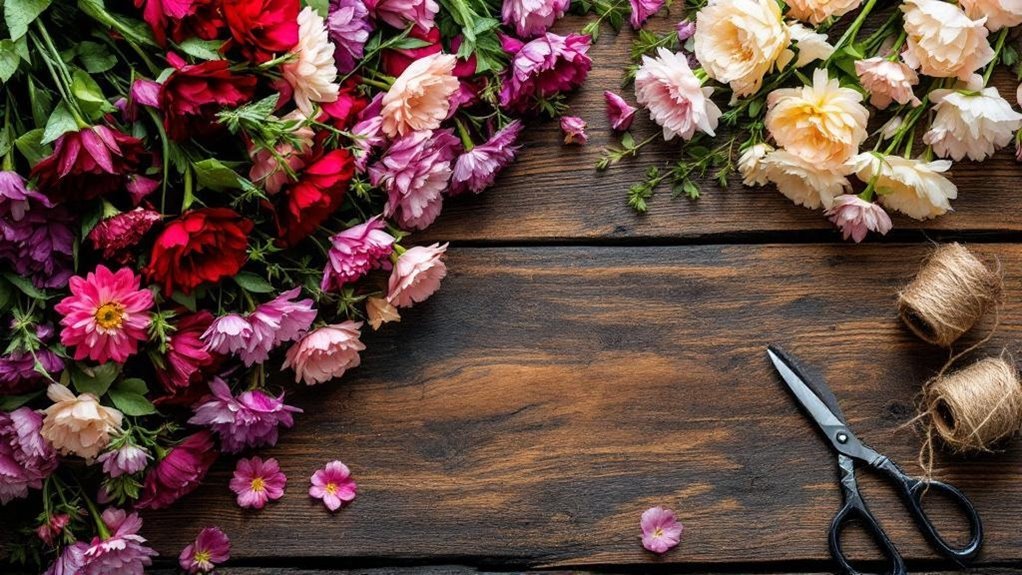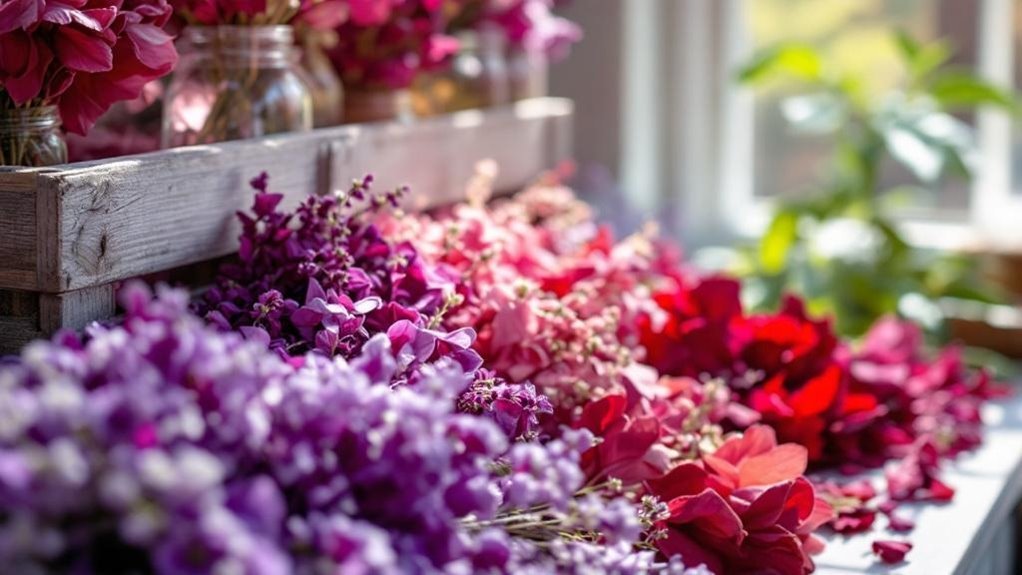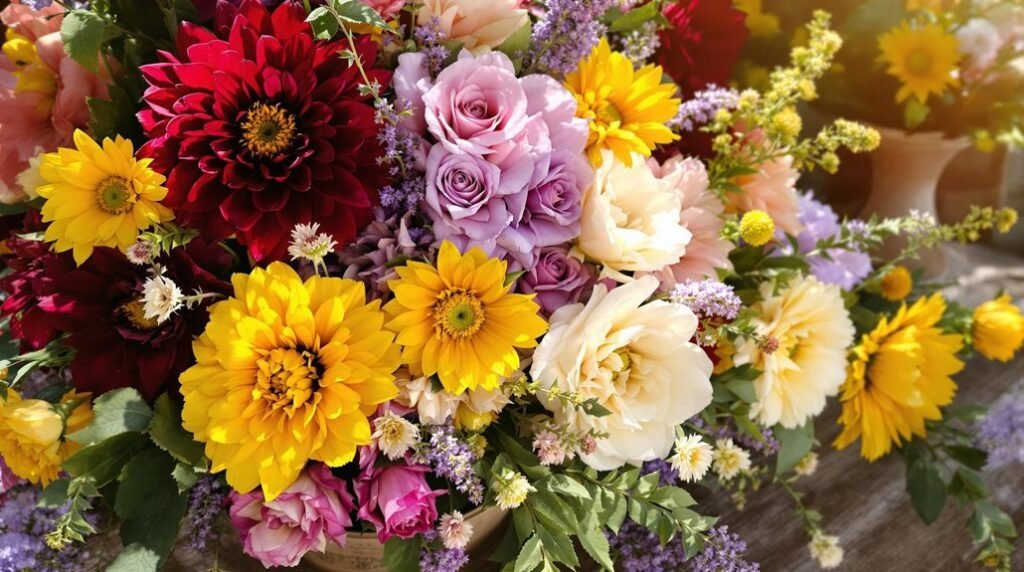You might not realize that not all flowers dry well or keep their color when preserved. Choosing the right varieties and knowing when to harvest can make all the difference in creating lasting, beautiful dried arrangements. If you’ve ever struggled with wilted or faded blooms, understanding these key steps will help you achieve vibrant results every time. Let’s explore what it takes to grow and preserve flowers that truly stand the test of time.
Choosing the Best Flowers for Drying
When you choose flowers for drying, pick varieties like Statice, Globe Amaranth, and Helichrysum because they hold their color and shape well over time.
These best flowers are prized for their excellent color retention and sturdy petals, making them ideal for dried arrangements. You should harvest flowers when they’re about three-quarters open to guarantee the best drying results.
Flowers with low moisture content, such as Strawflowers and Zinnias, also dry beautifully without wilting. Don’t forget to include filler flowers like Gypsophila; they add texture and depth to your compositions.
Aim for a diverse selection of annuals and perennials to create visually interesting dried arrangements. By choosing the right flowers and harvesting at the right time, you’ll get lasting, vibrant dried blooms every time.
Optimal Growing Conditions for Dried Flower Varieties
Selecting the right flowers is just the start; providing ideal growing conditions plays a big role in how well your blooms will dry. For dried flower varieties, make sure you plant in well-drained soil enriched with organic fertilizers to support healthy flower growth.
Choose a sunny spot that receives 6–8 hours of sunlight daily to promote best growth, especially for annuals and perennials like strawflowers and statice. Good airflow is vital to prevent moisture buildup, which can cause mold during the drying process.
Keep the soil moist but avoid overwatering to maintain balance. Managing weeds with mulch further improves soil health. By meeting these conditions, you’ll encourage sturdy, vibrant blooms that lead to better drying outcomes and long-lasting dried flower arrangements.
Harvesting Techniques for Long-Lasting Dried Blooms

Although timing your harvest carefully might seem minor, it greatly impacts the quality and longevity of your dried blooms. Harvest flowers in the late morning after dew dries to lower moisture. Use sharp shears to cut stems at the right length, leaving them long for flexible dried arrangements. Secure small bunches with rubber bands to keep stems tight and improve air drying. Hang upside down in a dark, dry, ventilated space, ensuring bunches don’t touch for even drying. Check stems often; when they snap, they’re ready to preserve.
| Emotion | Action |
|---|---|
| Satisfaction | Harvesting at the right time |
| Confidence | Using rubber bands to secure stems |
| Pride | Hanging flowers upside down to dry |
Effective Methods for Drying and Preserving Flowers
Because preserving your flowers properly guarantees their beauty lasts, you’ll want to choose the right drying method for each type.
When drying flowers, consider the flower’s shape and moisture levels to preserve flowers effectively from fresh bouquets into dried flower arrangements.
- Air-drying: Bundle stems and hang them upside down in a dry, dark place with good air circulation for 2-3 weeks. This simple method works well for flowers with low moisture.
- Silica gel: Place flowers in a container filled with silica gel, covering them completely. Seal it to absorb moisture quickly while retaining color and shape.
- Microwave drying: For thin petals, microwave in 30-second intervals on a paper towel-lined plate, checking often to avoid overheating.
Always store dried flowers in airtight containers away from light and humidity to maintain moisture levels.
Creative Uses and Storage of Dried Flower Arrangements

Once you’ve dried your flowers using the right method, you can start exploring creative ways to showcase them.
Use dried flowers in wreaths, centerpieces, or as decorative accents to enhance your home decor with lasting beauty. For seasonal crafting, try pressed flowers framed as wall art or unique gift toppers.
When storing your preserved arrangements, place them in an airtight container lined with tissue paper to prevent moisture absorption. Adding silica gel packets inside the storage container helps keep humidity at bay, extending the life of your dried flowers.
Selecting blooms like statice or amaranth during drying and preserving guarantees vibrant colors.
With these tips, you’ll enjoy your dried flowers’ charm for years while keeping them fresh and visually appealing.
Frequently Asked Questions
How to Preserve Dried Flowers Permanently for Decoration?
You should store dried flowers in airtight containers with silica gel to prevent moisture. Keep them away from direct sunlight, handle gently to avoid breakage, and regularly check for pests or humidity to preserve them permanently.
What Are the Best Flowers to Grow for Dried Flowers?
Like treasures in a chest, you’ll want statice, strawflowers, and globe amaranth for dried flowers. They hold color well. Add celosias and dahlias for texture and vibrancy. You’ll enjoy their lasting beauty effortlessly.
How Long Will a Dried Flower Arrangement Last?
You can expect your dried flower arrangement to last about a year, especially if you keep it in a cool, dry place away from sunlight. Proper storage and regular checks will help maintain its beauty longer.
How to Store Dried Flowers so They Don’t Mold?
Did you know mold can develop within 48 hours in humid conditions? To prevent this, store dried flowers in airtight containers with desiccants, keep them completely dry, separate varieties with paper, and avoid direct sunlight and moisture.
Final Thoughts
By choosing vibrant flowers like Statice and Strawflowers, you’ll create dried arrangements that whisper stories of sunny days and gentle breezes. With careful harvesting and drying in a cool, dark space, your blooms will hold their color and shape like captured sunlight. As you store them in airtight containers, imagine preserving moments of nature’s beauty, ready to brighten your space and heart long after the garden has gone quiet.
